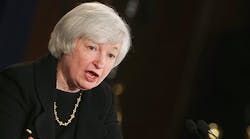WASHINGTON - The Federal Reserve decided Wednesday to end its quantitative easing stimulus program after six years of pumping easy money into the U.S. economy via asset purchases to shore up growth.
Revealing increasing confidence in a modestly expanding economy despite slower growth elsewhere, the Fed also trimmed its earlier doubts about the strength of the labor market.
It said the market, after several months of solid job creation, has shown "substantial improvement and that labor market slack -- an issue that has clearly bothered Fed Chair Janet Yellen since the beginning of the year -- was diminishing.
That justified calling an end to the innovative QE operations launched in the 2008 crisis, which involved making huge buys of Treasury bonds and mortgage securities as a way of injecting funds into the weak economy.
Over six years and three separate QE rounds, the Fed has bought up some $3.5 trillion in assets to keep interest rates low and encourage investment.
The Fed has now officially shifted into a neutral policy gear, not buying or selling assets, not cutting or hiking interest rates."— Michael Gregory, BMO Capital Markets
Despite their slight bullish turn, the policy makers of the Federal Open Market Committee stuck to the ultra-low interest rate policy they have maintained since the crisis.
They reassured that they would not raise the benchmark federal funds rate from the current 0% to 0.25% level for "a considerable time" after the end of the QE program, sticking to the earlier timetable of probably not before mid-2015.
The two key policy signals from the FOMC were expected. For the Fed it represents the beginning of policy "normalization" after six years of a crisis stance.
QE3, the latest version of the stimulus program, had been tapered from $85 billion a month last December to just $15 billion this month, and economists have said that its impact on overall growth has been less and less.
The principal aim for the policy was to help bring down the unemployment rate, which peaked at 10% in October 2009 and fell steadily to 5.9% last month.
Yet the end of QE technically will not amount to tighter money. The Fed says it will not sell off the assets, and for those maturing it will roll them over in the near term -- keeping the easy dollars sloshing about the global financial system.
"The Fed has now officially shifted into a neutral policy gear, not buying or selling assets, not cutting or hiking interest rates," said Michael Gregory of BMO Capital Markets.
"How long the Fed remains in this gear will of course be data dependent," he added, echoing a point the FOMC itself stressed.
With jobs growth now running at a firm clip, the Fed's focus has turned to inflation, which remains well below its 2% target.
While a recent weakness in prices has evoked concerns from some economists -- especially with the Eurozone fighting deflation -- the FOMC suggested it was not worried, saying longer-term expectations "remain stable."
That added to what analysts said was a clearly "hawkish" turn by the FOMC.
"There can be no doubt that the Fed could have sounded more dovish on the inflation outlook if it had wanted," said Harm Bandholz of UniCredit.
Copyright Agence France-Presse, 2014



